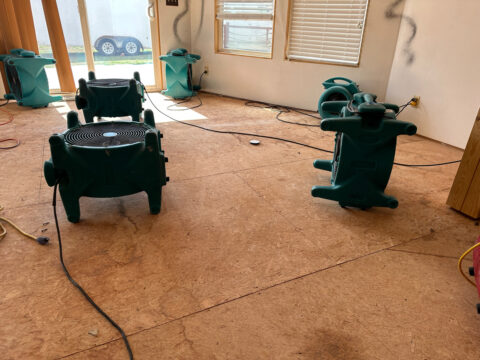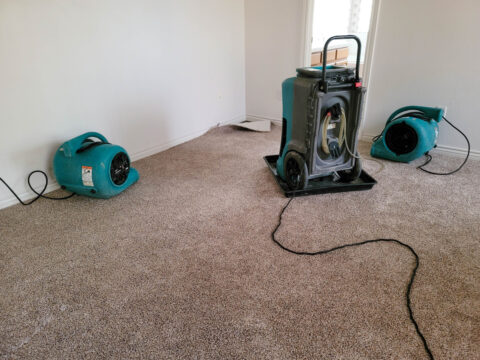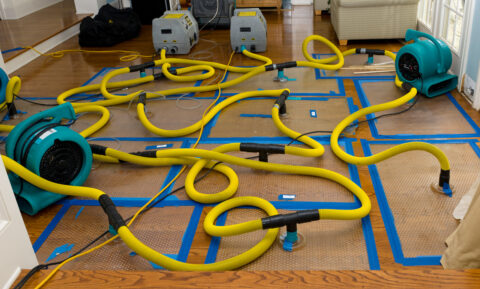 Very few events can create more issues for your home or business than water damage. After significant water damage, the structural elements of your building will act as a sponge, soaking up any water it comes into contact with. If not properly addressed, this water can weaken and potentially destroy your walls, floors, ceilings and other structural elements of your home or business. This is why structural drying is the most critical step in the water damage restoration process.
Very few events can create more issues for your home or business than water damage. After significant water damage, the structural elements of your building will act as a sponge, soaking up any water it comes into contact with. If not properly addressed, this water can weaken and potentially destroy your walls, floors, ceilings and other structural elements of your home or business. This is why structural drying is the most critical step in the water damage restoration process.
Simply using mops, rags and other household items will not be sufficient to dry your property after water damage. Similarly, using fans purchased at your local hardware store won’t provide the results you need to ensure all structures are completely dried. Water can seep into porous materials such as drywall, wood floors, insulation, and other structures in your property. Over time, this will result in significant structural damage and promote mold growth.
It’s critical to work with a professional water damage restoration company who can perform moisture testing to determine the true extent of the water damage. In addition, water damage restoration companies use advanced technology and proven techniques to ensure every structure is properly dried and repaired. By having this important process done by licensed professionals, you can prevent more extensive and costly structural damage from developing.
What Is Structural Drying?
Structural drying is a specialized process used by professional water damage restoration companies to thoroughly and completely remove all moisture from water damaged materials in your property, ensuring they are completely dry moving forward. This process enables you to preserve more of the structural materials used in your home or business, saving you considerable time and money compared to completely removing and replacing all water damaged structures.
Without proper structural drying from restoration professionals, water damage can potentially result in a variety of significant issues to your property, including:
- Structural Damage – Prolonged exposure to water can weaken the structural integrity of your home or business. Wood can warp, drywall may crumble, and insulation can lose its effectiveness. These issues can compromise the safety of the building and lead to costly repairs.
- Electrical Hazards – Water damage can affect the electrical system in your home or business, creating fire hazards and potential shocks. Even if the water damage doesn’t directly come into contact with electrical sources, moisture can travel through walls and floors, eventually reaching the electrical components within the structure of the building.
- Mold Growth – Inadequate drying of your property will create an ideal environment for mold to grow. You can experience significant mold growth within a day or two of water damage, making it critical to begin the drying process at once.
- Indoor Air Quality Issues – Lingering moisture due to improper drying can impact the air quality in your home or business, resulting in musty odors and potentially harmful airborne contaminants. This can negatively impact the health of individuals who spend a significant amount of time at your property.
- Secondary Damage – Failing to properly dry out your property can result in rusting and corrosion of metal components, further compromising the building’s structural integrity.
- Additional Health Hazards – In addition to the health hazards associated with mold growth and poor indoor air quality, improper drying after water damage can create an optimal breeding ground for a variety of harmful bacteria that will pose serious health risks. This is especially true in cases involving contaminated water.
- Pest Infestations – Moisture-rich environments can attract pests, resulting in additional problems and potential health risks.
- Reduced Property Value – Failing to properly dry your home or business after water damage can significantly decrease your property value, resulting in long-term financial implications.
Structural drying is critical to your ability to minimize additional damage and restore your property to its pre-damaged condition.
Key Components of Structural Drying

- Moisture Testing – Moisture testing is performed using specialized equipment to determine the extent and location of all water damage in the structural materials of your property.
- Water Extraction – Specialized equipment is used to remove as much standing water as possible from your property.
- Evaporation – Industrial powered air movers are used to increase air circulation and promote the evaporation of any remaining moisture.
- Dehumidification – Dehumidifiers are used to remove moisture from the air, preventing additional damage to structural materials.
- Moisture Testing – Once this process is complete, moisture testing is performed again to confirm that all structural materials are completely dry, and your property isn’t at risk of additional damage.
Specialized Equipment and Advanced Techniques Used in Structural Drying
Water damage restoration companies use specialized equipment and advanced techniques to ensure structural drying is performed correctly.
The following equipment is used as part of the structural drying process:
- Flood Extractor – Flood extractors are high-powered vacuums that use powerful suction to remove excess standing water from carpets, flooring and other surfaces.
- Air Movers – Air movers are high-powered fans that speed up the drying process to help prevent additional damage or mold growth.
- Dehumidifiers – After standing water is extracted, dehumidifiers will extract additional remaining moisture and help speed up the drying process.
- Fans – Industrial-grade fans are used in conjunction with air movers and dehumidifiers to expedite the drying process.
- Air Scrubbers – Air scrubbers are used to remove mold, dust, odors and other contaminants left behind after water damage, and they play a critical role in improving the air quality in your home or business.
- Moisture Meters – Moisture meters are used to measure the moisture content in the air, and they help your water damage restoration team confirm that all excess moisture has been removed at the end of the structural drying process.
In addition, advanced techniques such as moisture mapping are used to identify areas with high concentrations of moisture after water damage.
How Long Does it Take to Complete the Structural Drying Process?

Factors impacting the time it takes to completely dry your property after water damage include:
- Extent of the water damage
- Types of materials affected
- Size and layout of the affected area
- Environmental conditions, such as temperature and humidity
- Drying techniques and equipment used
Signs that Your Property Isn’t Drying Properly
Structural drying is a complex process that must be performed correctly to ensure effective results. The following signs may indicate that your property isn’t drying properly after water damage:
- Persistent Moisture Readings – If the moisture meters used by water damage restoration professionals remain high or fail to show progress towards reaching acceptable moisture levels, it’s generally an indication of improper drying.
- Visible Signs – Dark patches, damp walls and condensation on surfaces indicate that you’re still experiencing moisture issues.
- Unbalanced Humidity – If the humidity in affected areas remains higher than in unaffected areas, it’s a sign that the materials in the affected areas are still holding excess moisture.
- Musty Odors – Lingering musty odors is a sign that moisture is still trapped in materials and may be causing mold growth.
- Warping or Deformation – Materials such as drywall and wood may show visible warping or deformation if they’re not drying correctly.
- Slow Progress – If the structural drying process is taking significantly longer than expected, it may be a sign that hidden moisture pockets remain.
- Temperature Inconsistencies – Unusual cold spots in walls or floors may indicate that moisture is trapped in these structures.
your local FLEET company Can Help with Structural Drying After Water Damage
Due to the serious issues that can occur if structural drying isn’t completed properly, it’s critical that you work with licensed water damage restoration company. At your local FLEET company, we have the experience to ensure this process is handled correctly.
your local FLEET company has been the leading water damage restoration company in your area since 1954. Our team is fully licensed and certified, and we adhere to a strict process based on industry best practices for every aspect of the water damage restoration process. Our team uses specialized equipment and the most advanced techniques to ensure all structural drying is completed correctly.
In addition, we coordinate with your insurance company, eliminating the headaches associated with having to document all damage yourself. This assistance ensures a smoother claims process and helps you maximize the benefits to which you’re entitled.
Contact us today at 844-967-4911 to schedule an appointment. your local FLEET company serves customers in your area.
